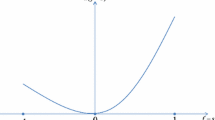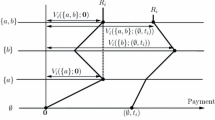Abstract
We study the problem of the location of a public facility that generates negative externalities. We consider that agents have single-dipped preferences with satiation: each agent considers a location as the worst, the “dip”, and the farther the location is from the dip, the better for the agent. In addition, an agent might be indifferent between all the locations sufficiently far from his dip, reaching his highest level of satisfaction. We characterize the family of strongly group strategy-proof and unanimous rules. Opposite to previous results without satiation, the locations selected are not necessarily at the extremes of the alternatives’ space.








Similar content being viewed by others
Notes
Another interpretation is as follows: apply the consensus rule, \( C^{d}(R)\), proposed by Manjunath (2014). This will select \(b\in \{0,T\}\). If there exist an alternative a that Pareto-dominates b, then choose a.
In our case, the default d corresponds to the bias b.
References
Barberà S, Berga D, Moreno B (2010) Individual versus group strategy-proofness: when do they coincide? J Econ Theory 145:1648–1674
Barberà S, Berga D, Moreno B (2012a) Domains, ranges and strategy-proofness: the case of single-dipped preferences. Soc Choice Welf 39:335–352
Barberà S, Berga D, Moreno B (2012b) Group strategy-proof social choice functions with binary ranges and arbitrary domains: characterization results. Int J Game Theory 41:791–808
Bogomolnaia A, Nicolò A (2005) Stable assignment of public facilities under congestion. J Public Econ Theory 7:65–91
Bossert W, Peters H (2012) Single-plateaued choice. Working Paper, Maastricht Research School of Economics of Tecnhology and Organization
Cantala D (2004) Choosing the level of a public good when agents have an outside option. Soc Choice Welf 22:491–514
Ehlers L (2002) Multiple public goods and lexicographic preferences: replacement principle. J Math Econ 37:1–15
Ehlers L (2003) Mutiple public goods, lexicographic preferences and single-plateaued preferences rules. Games Econ Behav 43:1–27
Freudenberg W, Pastor S (1992) NIMBYs and LULUs: stalking the syndromes. J Soc Issues 48:36–61
Gibbard A (1973) Manipulation of voting schemes: a general result. Econometrica 41:587–601
Manjunath V (2014) Efficient and strategy-proof social choice when preferences are single-dipped. Int J Game Theory 43:579–597
Moulin H (1980) On strategy-proofness and single-peakedness. Public Choice 35:437–455
Öztürk M, Peters H, Storcken T (2012) Strategy-proof location of a public Bad on a Disc., Working Paper, Maastricht Research School of Economics of Tecnhology and Organization
Satterthwaite M (1975) Strategy-proofness and arrow’s conditions: existence and correspondence theorems for voting procedures and social welfare functions. J Econ Theory 10:187–217
Acknowledgments
We thank our PhD advisors, Jordi Massó and Salvador Barberà for their patience, inspiration, and to all comments we received along these years. Special thanks to William Thomson and two anonymous refereers for their suggestions and comments.
Author information
Authors and Affiliations
Corresponding author
Appendix
Appendix
Lemma 1
Let \(b\in \{0,T\}\) and \(R\in {\mathcal {R}}_{D}^{n}\) be such that \(U(R)=\emptyset \). If \(E(b;R)\not =\emptyset \), then \(\#E(b;R)=1\).
Proof
Let \(b=0\) and \(R\in {\mathcal {R}}_{D}^{n}\) be such that \( U(R)=\emptyset \) and \(E(0;R)\not =\emptyset \). Then, there exists at least one alternative \(a\in P(R)\), such that \(aR_{i}0\) for all \(i\in N\) and \( aP_{j}0\) for some \(j\in N\). Since \(U(R)=\emptyset \), then \( N_{0}(R)\not =\emptyset \) and \(N_{T}(R)\not =\emptyset \). By definition \( 0\not \in E(0;R)\).
First, take any \(i\in N_{0}(R)\). By definition, \(0P_{i}T\) and any \(x\in [0,l(R_{i})]\) is such that \(xI_{i}0\), and any \(k\in (l(R_{i}),T]\) is such that \(0P_{i}k\). Hence, no alternative \(k^{\prime }\in (l_{min}(R_{N_{0}(R)}),T]\) belongs to E(0; R). As \(E(0;R)\not =\emptyset \) and \(0\not \in E(0;R)\), \(E(0;R)\subseteq (0,l_{min}(R_{N_{0}(R)})]\). Hence, any alternative \(a\in E(0;R)\) is such that \(aI_{i}0\) for each \(i\in N_{0}(R).\)
Second, take any \(i\in N_{T}(R)\). Then, \(TP_{i}0\) and any alternative \(y\in [h(R_{i}),T]\) is such that \(yP_{i}0\). Notice that for each \(i\in N_{T}(R)\), \(\max W(0;R_{i})=cI_{i}0\) and any \(w\in \) \(W(0;R_{i})\diagdown \{c\}\) is such that \(0P_{i}w\). Hence, for every agent \(i\in N_{T}(R)\) it should be that if \(a\in E(0;R)\), then \(a\in [c,T]\). Therefore, \( E(0;R)\subseteq [\overline{c}(R),T]\).
If \(N_{0T}(R)=\emptyset \) and as \(U(R)=\emptyset \), then \( l_{min}(R_{N_{0}(R)})<h_{max}(R_{N_{T}(R)})\). Furthermore, \(E(0;R)\subseteq (0,l_{min}(R_{N_{0}(R)})]\cap [\overline{c}(R),T]\). As it should be that for all \(i\in N_{0}(R),a\in E(0;R)\) is such that \(aI_{i}0\), then it can not be that an alternative \(z\in (h_{max}(R_{N_{T}(R)}),T]\) belongs to E(0; R), because \(0P_{i}z\) for any \(i\in N_{0}(R)\). Therefore, \(\overline{c} (R)\le l_{min}(R_{N_{0}(R)})\ \)and \(E(0;R)\subseteq (0,l_{min}(R_{N_{0}(R)})]\).
We can distinguish between two cases:
Case (i) \(\overline{c}(R)<\) \(l_{min}(R_{N_{0}(R)})\). By definition, \( a>b>d(R_{i})\) implies that \(aP_{i}bP_{i}d(R_{i})\). Hence, for any alternative \(x>\overline{c}(R)\) it is that \(xR_{i}\overline{c}(R)\) for each \( i\in N_{T}(R)\) and \(xP_{j}\overline{c}(R)\) for some \(j\in N_{T}(R)\). Then, \( l_{min}(R_{N_{0}(R)})R_{i}\overline{c}(R)P_{i}0\) for all \(i\in N_{T}(R)\) and \(l_{min}(R_{N_{0}(R)})P_{j}\overline{c}(R)P_{i}0\) for some \(j\in N_{T}(R)\). Furthermore, \(l_{min}(R_{N_{0}(R)})I_{i}0\) for all \(i\in N_{0}(R)\). Any other alternative \(y\in (0,l_{min}(R_{N_{0}(R)}))\) is such that \( l_{min}(R_{N_{0}(R)})P_{i}y\) for some \(i\in N_{T}(R)\); hence \(y\not \in P(R)\). We conclude that \(l_{min}(R_{N_{0}(R)})=E(0;R)\) (Fig. 9).
Case (ii) \(\overline{c}(R)=l_{min}(R_{N_{0}(R)})\). Then \( (0,l_{min}(R_{N_{0}(R)})]\cap [\overline{c}(R),T]=\) \(E(0;R)=\overline{ c}(R)=l_{min}(R_{N_{0}(R)})\) (Fig. 10).
Suppose that \(N_{0T}(R)\not =\emptyset \). Then, \(i\in N_{0T}(R)\) it should be that \(0I_{i}T\) and any \(x\in [0,l(R_{i})]\cup [h(R_{i}),T]\) is such that \(xI_{i}0\), and any \(y\in (l(R_{i}),h(R_{i}))\) is such that \( 0P_{i}y\). Hence, no alternative \(y\in (l(R_{i}),h(R_{i}))\) belongs to E(0; R). Then, for any \(a\in E(0;R)\) and any \(i\in N_{0T}(R)\) it should be that \(aI_{i}0\). Hence, \(E(0;R)\subseteq U(R_{N_{0T}(R)})\diagdown \{0\}\) and \([0,l_{min}(R_{N_{0T}(R)})]\cup [h_{max}(R_{N_{0T}(R)}),T]\subseteq U(R_{N_{0T}(R)})\).
Adding up, when \(N_{0T}(R)\not =\emptyset \), \(N_{0}(R)\not =\emptyset \) and \( N_{T}(R)\not =\emptyset \), then \(E(0;R)\subseteq (0,l_{min}(R_{N_{0}(R)})]\cap [\overline{c}(R),T]\cap U(R_{N_{0T}(R)})\). In such case, we distinguish between two cases:
Case (iii) \(l_{min}(R_{N_{0}(R)})\le l_{min}(R_{N_{0T}(R)})\). For any \(a\in E(0;R)\) it should be that \(aI_{i}0\) for all \(i\in N_{0}(R)\cup N_{0T}(R)\). Any alternative \(x\in (0,l_{min}(R_{N_{0}(R)})]\) accomplishes this latter condition. Furthermore, any \(y\in U(R_{N_{0T}(R)})\diagdown [0,l_{min}(R_{N_{0}(R)})]\) is such that \(0P_{i}y\) for all \(i\in N_{0}(R)\) although \(0I_{i}y\) for all \(i\in N_{0T}(R)\). As \(E(0;R)\not =\emptyset \), \( N_{0}(R)\not =\emptyset \), and \(N_{T}(R)\not =\emptyset \), \(\overline{c} (R)\le l_{min}(R_{N_{0}(R)})<T\). Hence \(E(0;R)\subseteq (0,l_{min}(R_{N_{0}(R)})]\). By definition, \(a>b>d(R_{i})\) implies \( aP_{i}bP_{i}d(R_{i})\). Since \(d(R_{i})\le \overline{c}(R)\le \) \( l_{min}(R_{N_{0}(R)})\), for any \(i\in N_{T}(R)\) and any alternative \(e> \overline{c}(R)\), \(eP_{i}\overline{c}(R)\). Furthermore \(\overline{c} (R)R_{i}0 \) for all \(i\in N_{T}(R)\) and \(\overline{c}(R)P_{j}0\) for some \( j\in N_{T}(R)\). Then, \(l_{min}(R_{N_{0}(R)})P_{i}\overline{c}(R)P_{i}0\) for some \(i\in N_{T}(R)\) and \(l_{min}(R_{N_{0}(R)})R_{i}0\) for all \(i\in N\). We conclude that \(l_{min}(R_{N_{0}(R)})=E(0;R)\) (Fig. 11).
Case (iv) \(l_{min}(R_{N_{0}(R)})>l_{min}(R_{N_{0T}(R)})\). For any \(a\in E(0;R) \) it should be that \(aI_{i}0\) for all \(i\in N_{0}(R)\cup N_{0T}(R)\). Any alternative \(x\in (0,l_{min}(R_{N_{0T}(R)})]\) accomplishes this latter condition, however, it is not the unique interval with this property. There might exist a preference profile \(R\in {\mathcal {R}}_{D}^{n}\) where there exist an interval \([h(R_{j}),l(R_{j^{\prime }})]\) for \(j,j^{\prime }\in N_{0T}(R)\), \(j\not =j^{\prime }\) such that any alternative \(y\in [h(R_{j}),l(R_{j^{\prime }})]\) is such that \(y\not \in (0,l_{min}(R_{N_{0T}(R)}))\) and \(yI_{i}0\) for all \(i\in N_{0}(R)\cup N_{0T}(R)\). This opens the possibility of three subcases:
(iv.a) There is no alternative \(x\in U(R_{N_{0T}(R)})\) such that \(x\in (l_{min}(R_{N_{0T}(R)}),l_{min}(R_{N_{0}(R)})]\). Hence, for any \( y\in (l_{min}(R_{N_{0T}(R)}),l_{min}(R_{N_{0}(R)})]\) it is that \(0R_{i}y\) for all \(i\in N_{0T}(R)\) and \(0P_{j}y\) for some \(j\in N_{0T}(R)\). Hence, \( y\not \in E(0;R)\). Furthermore, any alternative \(z\in (l_{min}(R_{N_{0}(R)}),T]\) is such that \(0R_{i}z\) for all \(i\in N_{T}(R)\) and \(0P_{j}z\) for some \(j\in N_{T}(R)\). Hence, \(z\not \in E(0;R)\). Therefore, any \(a\in E(0;R)\) should be such that \(a\in [\overline{c} (R),l_{min}(R_{N_{0T}(R)})]\). Since \(d(R_{i})\le \overline{c}(R)\le \) \( l_{min}(R_{N_{0T}(R)})\), for any \(i\in N_{T}(R)\) and any alternative \(e\ge \overline{c}(R)\), \(eR_{i}\overline{c}(R)\) and \(eP_{j}\overline{c}(R)\) for some \(j\in N_{T}(R)\). Then, \(l_{min}(R_{N_{0T}(R)})P_{i}\overline{c} (R)P_{i}0 \) for some \(i\in N_{T}(R)\) and \(l_{min}(R_{N_{0T}(R)})R_{i}0\) for all \(i\in N\). We conclude that \(l_{min}(R_{N_{0T}(R)})=E(0;R)\) (Fig. 12).
(iv.b) There exists an alternative \(x\in U(R_{N_{0T}(R)})\) such that \(x\in (l_{min}(R_{N_{0T}(R)}),l_{min}(R_{N_{0}(R)})]\) and there is no interval \([h(R_{j}),l(R_{j^{\prime }})]\subset U(R_{N_{0T}(R)})\) for \( j,j^{\prime }\in N_{0T}(R)\) such that \(l(R_{j^{\prime }})>l_{min}(R_{N_{0}(R)})>h(R_{j})>l_{min}(R_{N_{0T}(R)})\). First, notice that \(x\not =l_{min}(R_{N_{0}(R)})\) as there is no a unanimous interval for \( N_{0T}(R)\) that includes that alternative. Furthermore, as any \(a\in E(0;R)\) should accomplish that \(aI_{i}0\) for all \(i\in N_{0}(R)\cup N_{0T}(R)\), then \(a\in (0,l_{min}(R_{N_{0}(R)}))\). As \(N_{T}(R)\not =\emptyset \), then \(a\in [\overline{c}(R),l_{min}(R_{N_{0}(R)}))\). Let \(\overline{l} (R_{N_{0T}(R)})=\underset{i\in N_{0T}(R)}{\max }\{\max l(R_{i}):l(R_{i})\in U(R_{N_{0T}(R)})\) and \(l(R_{i})<l_{min}(R_{N_{0}(R)})\}\). As \( E(0;R)\not =\emptyset \) it should be that \(\overline{l}(R_{N_{0T}(R)})\ge \overline{c}(R)\), otherwise there is no alternative \(y\in [\overline{c}(R),l_{min}(R_{N_{0}(R)}))\) such that \(yI_{i}0\) for any \(i\in N_{0T}(R)\). Adding up, \(l_{min}(R_{N_{0}(R)})>\overline{l}(R_{N_{0T}(R)})\ge \overline{c }(R)\le l_{min}(R_{N_{0T}(R)})\) and any \(a\in E(0;R)\) is such that \(a\in [\overline{l}(R_{N_{0T}(R)}),l_{min}(R_{N_{0}(R)}))\). However, no alternative \(z\in (\overline{l}(R_{N_{0T}(R)}),l_{min}(R_{N_{0}(R)}))\) belongs to \(U(R_{N_{0T}(R)})\). Hence, we conclude that \(\overline{l} (R_{N_{0T}(R)})=E(0;R)\) (Fig. 13).
(iv.c) There exists an alternative \(x\in U(R_{N_{0T}(R)})\) such that \(x\in (l_{min}(R_{N_{0T}(R)}),l_{min}(R_{N_{0}(R)})]\) and there is an interval \([h(R_{j}),l(R_{j^{\prime }})]\subset U(R_{N_{0T}(R)})\) for \( j,j^{\prime }\in N_{0T}(R)\) such that \(l(R_{j^{\prime }})\ge l_{min}(R_{N_{0}(R)})>l_{min}(R_{N_{0T}(R)})>h(R_{j})\). First, notice that \( h(R_{j})\not =l_{min}(R_{N_{0T}(R)})\) and that \(l_{min}(R_{N_{0}(R)})I_{i}0\) for all \(i\in N_{0T}(R)\cup N_{0}(R)\). For any \(a\in E(0;R)\) it should be that \(aI_{i}0\) for all \(i\in N_{0T}(R)\cup N_{0}(R)\), hence, \(a\in U(R_{N_{0T}(R)})\) and \(a\le l_{min}(R_{N_{0}(R)})\). As \(N_{T}(R)\not = \emptyset \), \(a\ge \overline{c}(R);\) therefore \(\overline{c}(R)\le l_{min}(R_{N_{0}(R)})\). In particular, \(l_{min}(R_{N_{0}(R)})R_{i}0\) for all \(i\in N_{T}(R)\) and \(l_{min}(R_{N_{0}(R)})P_{j}0\) for some \(j\in N_{T}(R)\). By definition, for any other alternative y such that \( d(R_{i})<y<l_{min}(R_{N_{0}(R)})\), there exists an agent \(i^{\prime }\in N_{T}(R)\) such that \(l_{min}(R_{N_{0}(R)})P_{i^{\prime }}y\). Hence, we conclude that \(E(0;R)=l_{min}(R_{N_{0}(R)})\) (Fig. 14).
A symmetric argument can be used for the case where \(U(R)=\emptyset \) and \( E(T;R)\not =\emptyset \). \(\square \)
Rights and permissions
About this article
Cite this article
Ayllón, G., Caramuta, D.M. Single-dipped preferences with satiation: strong group strategy-proofness and unanimity. Soc Choice Welf 47, 245–264 (2016). https://doi.org/10.1007/s00355-016-0957-0
Received:
Accepted:
Published:
Issue Date:
DOI: https://doi.org/10.1007/s00355-016-0957-0










